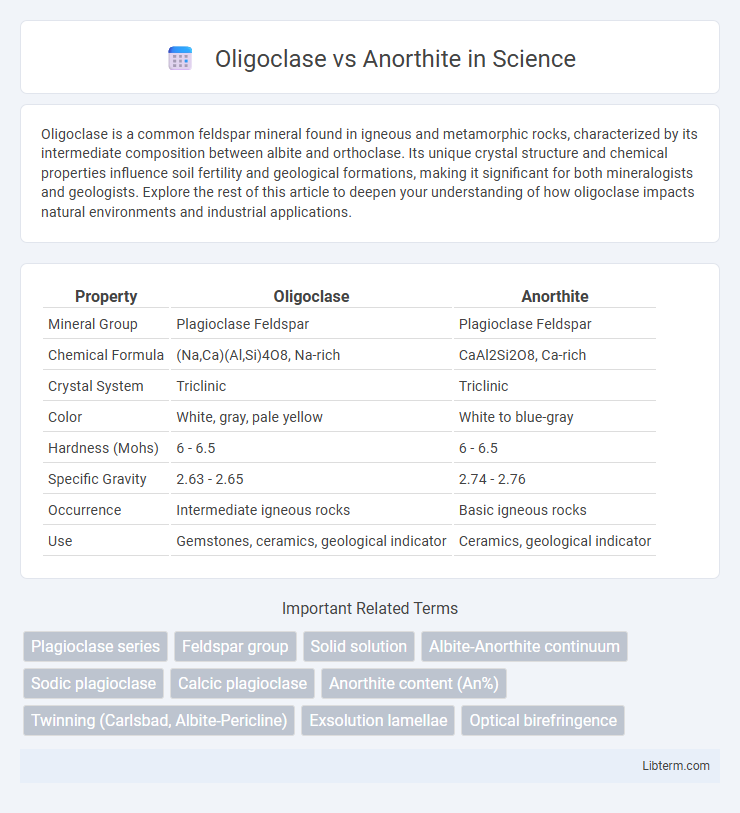Oligoclase is a common feldspar mineral found in igneous and metamorphic rocks, characterized by its intermediate composition between albite and orthoclase. Its unique crystal structure and chemical properties influence soil fertility and geological formations, making it significant for both mineralogists and geologists. Explore the rest of this article to deepen your understanding of how oligoclase impacts natural environments and industrial applications.
Table of Comparison
| Property | Oligoclase | Anorthite |
|---|---|---|
| Mineral Group | Plagioclase Feldspar | Plagioclase Feldspar |
| Chemical Formula | (Na,Ca)(Al,Si)4O8, Na-rich | CaAl2Si2O8, Ca-rich |
| Crystal System | Triclinic | Triclinic |
| Color | White, gray, pale yellow | White to blue-gray |
| Hardness (Mohs) | 6 - 6.5 | 6 - 6.5 |
| Specific Gravity | 2.63 - 2.65 | 2.74 - 2.76 |
| Occurrence | Intermediate igneous rocks | Basic igneous rocks |
| Use | Gemstones, ceramics, geological indicator | Ceramics, geological indicator |
Introduction to Oligoclase and Anorthite
Oligoclase and anorthite are both members of the plagioclase feldspar mineral series, distinguished by their chemical composition and crystal structure. Oligoclase contains a higher proportion of sodium (Na) ions, typically ranging between 10% to 30% anorthite content, making it a sodium-rich plagioclase, whereas anorthite is calcium-rich, with 90% to 100% anorthite content. These differences influence their physical properties, occurrence in igneous and metamorphic rocks, and their roles in petrological classification and geochemical studies.
Mineral Classification and Group Overview
Oligoclase and anorthite are feldspar minerals classified within the plagioclase series, which is part of the tectosilicate mineral group known for framework silicate structures. Oligoclase typically contains 10-30% anorthite component (CaAl2Si2O8), positioning it as a sodium-calcium aluminosilicate intermediate, whereas anorthite represents the calcium-rich end-member with nearly 100% anorthite content. These minerals are crucial in igneous and metamorphic petrology for classifying rock compositions based on their calcium-to-sodium ratios within the plagioclase feldspar solid solution series.
Chemical Composition Differences
Oligoclase is a sodium-rich plagioclase feldspar with the chemical formula (Na,Ca)(Al,Si)4O8, containing approximately 10-30% anorthite (CaAl2Si2O8) component. Anorthite, in contrast, is the calcium-rich end-member of the plagioclase series with the formula CaAl2Si2O8, characterized by higher calcium and aluminum content and lower sodium levels than oligoclase. The varying proportions of sodium and calcium ions in their crystalline structures significantly influence their physical properties and geological occurrences.
Crystal Structure Comparison
Oligoclase and Anorthite are both members of the plagioclase feldspar series, characterized by their triclinic crystal system. Oligoclase displays a crystal structure dominated by sodium and calcium ions, with a balanced mix that results in intermediate refractive indices and distinctive twinning patterns. In contrast, Anorthite contains a higher calcium content, leading to a more tightly packed lattice structure and a higher melting point compared to Oligoclase.
Physical Properties and Appearance
Oligoclase and anorthite are both members of the plagioclase feldspar series but differ significantly in physical properties and appearance. Oligoclase typically exhibits a white to pale gray color with a vitreous luster, a hardness of 6-6.5 on the Mohs scale, and a specific gravity around 2.63-2.64, whereas anorthite is usually darker, ranging from white to dark gray or greenish-blue, with a slightly higher hardness of 6-6.5 and a greater specific gravity of about 2.75-2.76. Cleavage in both minerals is distinct on two directions, but anorthite tends to show more pronounced blocky crystal forms compared to the more tabular or striated appearance of oligoclase.
Geological Occurrence and Formation
Oligoclase predominantly forms in igneous rocks such as granites and syenites, often appearing in metamorphic rocks like schists under medium-grade conditions. Anorthite typically occurs in mafic and ultramafic igneous rocks, including gabbros and norites, and is common in high-temperature metamorphic environments. Both feldspars crystallize from magma but differ in calcium and sodium content, influencing their stability in diverse geological settings.
Industrial and Practical Uses
Oligoclase is commonly used in the manufacturing of ceramics and glass due to its high alumina content and durability, providing enhanced strength and resistance to thermal shock. Anorthite, with its high calcium content, serves as a crucial raw material in the production of refractory materials and cement, improving heat resistance and structural integrity. Both minerals are essential in industrial applications where chemical stability and mechanical robustness are critical for performance.
Optical and Spectroscopic Features
Oligoclase typically exhibits lower birefringence and a lower refractive index (around 1.53-1.55) compared to anorthite, which has higher values (approximately 1.58-1.58+), resulting in more pronounced optical relief and interference colors. In spectroscopic analysis, oligoclase often shows a broader absorption band in the visible spectrum due to its higher sodium content, while anorthite's calcium-rich composition produces sharper absorption features, especially in the near-infrared range. These optical and spectroscopic distinctions are critical for precise mineral identification in petrographic microscopy and remote sensing applications.
Identification and Distinguishing Methods
Oligoclase and Anorthite are plagioclase feldspar minerals distinguishable by their distinctive anorthite content, with Oligoclase containing approximately 10-30% Anorthite and Anorthite exceeding 90%. Identification methods involve assessing optical properties under a petrographic microscope, where Oligoclase displays moderate birefringence and characteristic albite twinning, whereas Anorthite exhibits higher birefringence and distinct pericline twinning. Chemical analysis using X-ray fluorescence (XRF) or electron microprobe can precisely determine calcium and sodium ratios, aiding in accurate classification between these feldspar end-members.
Summary: Key Differences Between Oligoclase and Anorthite
Oligoclase and anorthite are both members of the plagioclase feldspar mineral series, distinguished primarily by their calcium and sodium content. Oligoclase contains 10-30% anorthite (calcium) and 70-90% albite (sodium), making it sodium-rich, whereas anorthite is calcium-rich with more than 90% calcium content. This compositional difference affects their physical properties, such as specific gravity and refractive index, with anorthite being denser and having a higher refractive index than oligoclase.
Oligoclase Infographic

 libterm.com
libterm.com